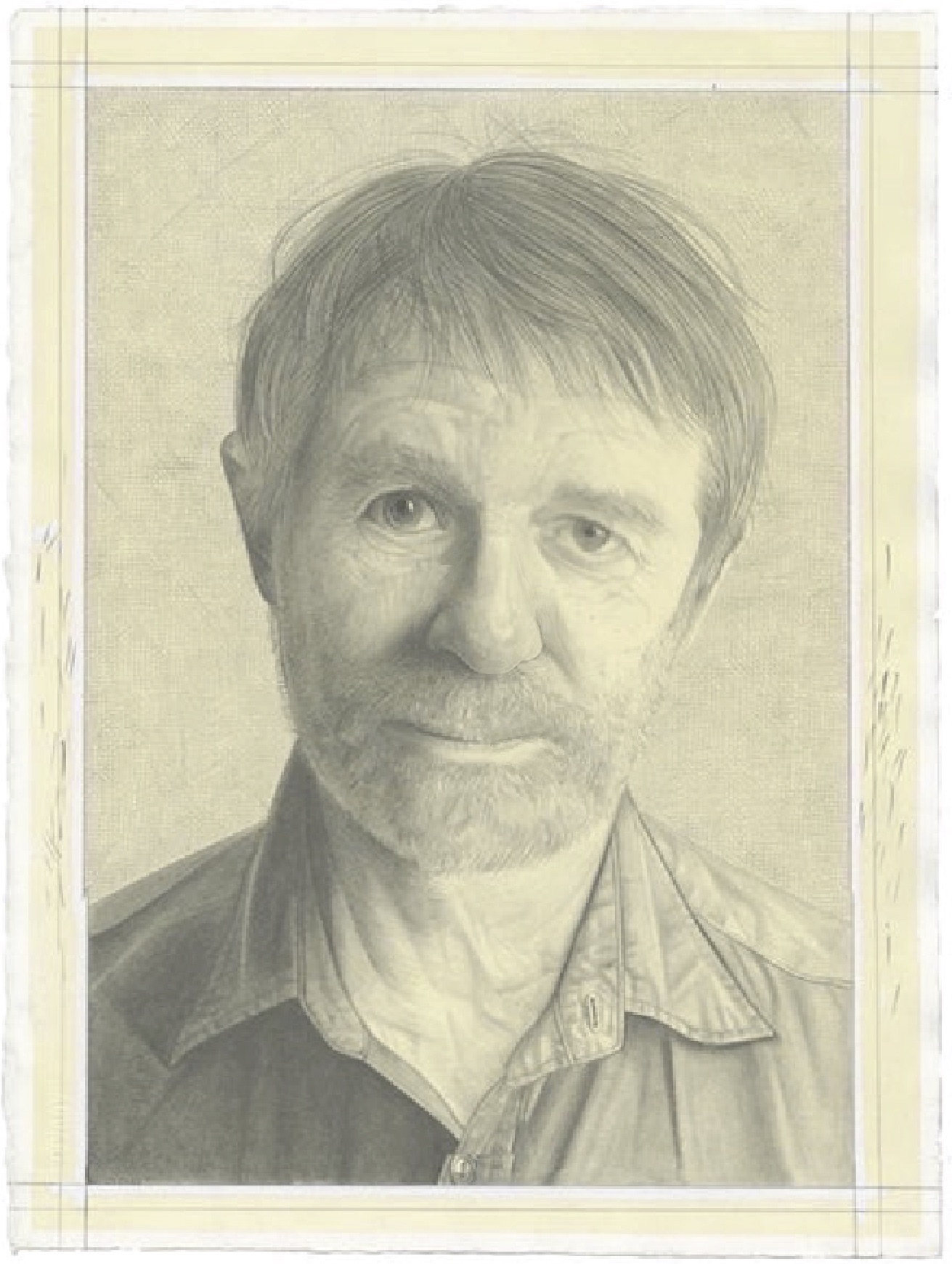|
Phong Bui (Rail): Ugo Rondinone told me once, in regards to Ai Weiwei's work, that he has no original ideas for his art. He was referring to Weiwei's reapplication of Minimalist and Conceptual ideas in particular. Take, for example, his 100 million hand-painted ceramic sunflower seeds or his 10,000 river crabs, which can be displayed in different configurations, either spreading out on the floor to fill a room in the manner of Walter De Maria's Earth Room, or piling up in a corner in the manner of Felix Gonzalez-Torres's candy installation ["Untitled" (Portrait of Ross in L.A.), 1991].
Allan McCollum: What Ugo said is true, but what's interesting is the way Weiwei has distributed himself, and his positions on social and political issues. Sometimes, artists are most interesting in the ways they distribute themselves through the objects they make, so that the objects and personal narratives are one. I think he does both very well. I especially like his earliest works, where he made smaller objects like those table-and-chair pieces with skillful joinery, and so on.
Rail: And Weiwei's deployment of repetition stems both from the West, which amplifies the image, and from the East, which empties the image.
McCollum: To get rid of yourself. You've reminded me. One artist who had a major influence on me was Vija Celmins, who I've known since the mid '60s.
Rail: In the Venice Beach days.
McCollum: Yes. She was interested in [G.I.] Gurdjieff at the time. I remember she had a photograph of the water without the horizon. I'm sure it's the same one she still uses. She would have a pencil and paper and would copy the photograph for I don't know how many hours, then she would put it aside, cover it with white paper, get another sheet of paper, and copy it again without looking at the one she had just done. She would do it over and over because she knew that each one she did would be different. Her focus would change slightly, she would be thinking a little bit differently, she was in a slightly different mood, so that when you looked at each one there would be minor differences. But that is what she was aiming to discover about herself and the world in general, the idea of work, deep focus, and repetition. You had to speak at least four or five languages to read Gurdjieff's books because he wanted you to have to work and concentrate really deeply. And working really hard, all the time, repetitively was a required discipline. I also remember I went to one meeting that Vija hosted at her studio with a bunch of different Gurdjieff people which must have been in 1968, '69. What was so interesting was that in every meeting there would be one word they couldn't use. When I was there, you couldn't say "I." So instead of saying, "I just thought of ... " you would have to use another word like, "It just thought of ... " I had to constantly focus to not say "I." [Laughter.] And this was an amazing part of Vija's discipline. In any case, I used to paint as a hobby in art classes in high school. But the first time I tried to make a serious painting, after I decided I wanted to be an artist—
Rail: In 1967.
McCollum: March, 1967. So, exactly fifty years ago.
Rail: Why such a specific month and year?
McCollum: It was an emotional moment. In my first painting, I tried to combine two influences into one: Vija, who worked from images taken from newspapers, and Roy Lichtenstein, who had done pictures out of comic books. First, I found an image in a newspaper similar to something Vija would have painted. I painted the image in gray paint, painting over a piece of window screen that I had laid onto the canvas. When the paint dried, I removed the screen so the painting would be composed of little dots. I don't have this painting anymore. I think the reason I remember it was that specific day I had had my heart broken by a girlfriend. She had been married to an artist, and I was studying restaurant management and industrial kitchen work. I met her at trade school and fell for her. She knew about so many things that I didn't. She was divorced by that time, but her husband had been a contemporary artist—still is. I'd learned about Jasper Johns, Rauschenberg, especially John Cage, among other New York artists, from her.
Rail: That was how you discovered Fluxus art?
McCollum: Well, my background had been in theater. Both my parents were actors, and many of my earliest memories were of watching them rehearse on stage. I was reading about theater and something I read mentioned experimental artists in New York. Some were Fluxus artists like George Maciunas and Robert Watts, and some were dancers like Yvonne Rainer and Lucinda Childs. But there was a chapter on Allan Kaprow and happenings. I then bought a book about happenings and was fascinated with it. I was also taking LSD at the time and different kinds of drugs that change the way you see things. So that led me to an interest in anthropology and learning how different cultures see things in different ways. I realized that my life could be more interesting if I were to learn different ways of seeing things. I had traveled a bit. I had hitchhiked across the country several times. I had hitchhiked through Morocco. I had hitchhiked through the British Isles, among other places. When I turned thirty, I spent a whole month in Mexico traveling throughout the country by myself. I had this desire to learn more about the world, but from my own point of view, not from reading. I was interested in all the different ways to look at the world, and there are millions of ways, if not billions. [Laughter.] So I think Allan Kaprow was very instrumental in the way he constructed his thinking and made happenings. But then, of course, learning about him opened all these doors to learn about other Fluxus artists, especially through The Great Bear Pamphlets.
I could buy them at this little bookstore on Fairfax in L.A. There were these cool bookstores in L.A. where you could buy beatnik literature, poetry, philosophy, and things like that, but this particular bookstore worked with Something Else Press, so I bought a number of their books. And these pamphlets were only about seventy-five cents to a dollar. That's how I came to know about Fluxus.
Rail: You didn't go to art school. But you met Al [Allen] Ruppersberg.
McCollum: In 1968. A year after he graduated from Chouinard Art Institute. We've been friends ever since. Al was and is one of those artists who's like no other, partly because he combines many different kinds of approaches in his head. And he was especially interested in common, everyday life, and popular culture—the way it changes the way we hold ourselves together, whether from newspapers, books, magazines, TV shows, and movies. Almost every one of his works for many years and even now involved popular culture.
Rail: Including archiving it, subversively transforming it into something else, as works of art.
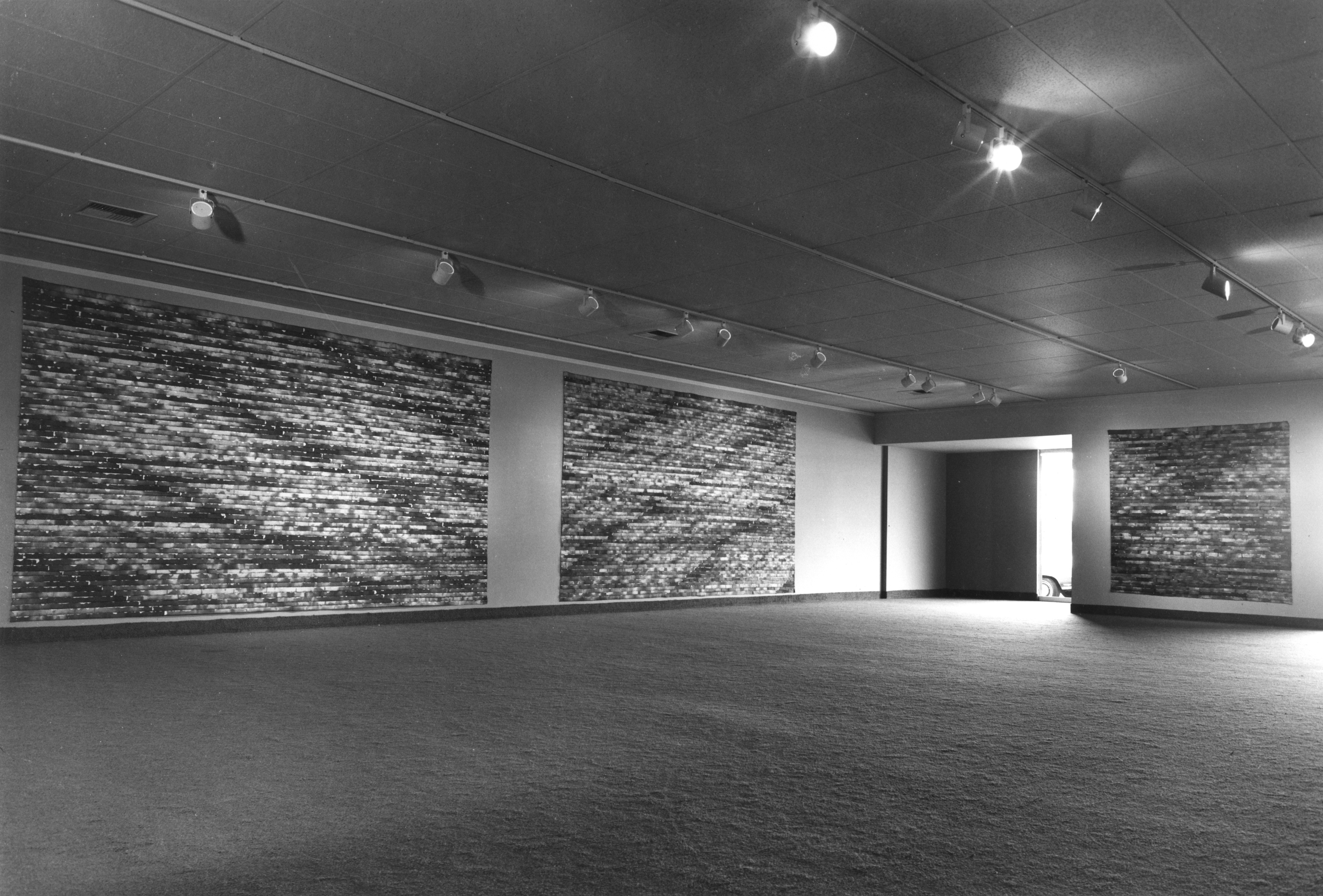
Allan McCollum, Constructed Paintings, 1971. Installation: Jack Glenn Gallery, Corona Del Mar, California, 1971
McCollum: My dialogue with Al has been very important to me. For example, in the group of paintings that you saw uptown at Petzel, I wanted to work with materials I could buy in a grocery or hardware store, not art supply stores—like bleach, dye, glitter, sand, silicone adhesive, and so on. I thought I could buy handkerchiefs, dye them gray, put tape on the handkerchiefs, throw bleach on them, rinse them out, then have all these stripes on them. Then I thought nobody would see that as art, but I kept it in the back of my head until I went to see the first major work of Al Ruppersberg which was Al's Café (1969) near MacArthur Park. I went for the opening night. I couldn't believe the logic of transforming a restaurant into an artwork just for the weekend or something like that.
Rail: It's outrageous and brilliant.
McCollum: It was. You can imagine, I went home and the next day I thought, "I'm going to start making those handkerchiefs." He changed what was permissible for me in terms of experimentation. One of my favorite experiences at Al's Café was when the police showed up. This was in the show's third week, I think. It was just open one night per week. The police showed up because he didn't have a license to serve beer and he was serving beer. I remember Rosamund Felsen jumping up, getting between Al and the policeman, and arguing that it was an artwork and that it wasn't breaking the law. "It's an artwork, it's like a party. It's not a real restaurant." She was my hero.
Rail: [Laughter.] Long before she had created her gallery!
McCollum: Yes, In the end the police made him close it, but they didn't charge him with anything.
Rail: So at this point you were friends with Al, which relates in some ways to Fluxus art, and being playful and experimental. But at the same time, you were interested in Bertolt Brecht and his "epic theater."
McCollum: I read about Brecht in the magazines I mentioned earlier. Also, when I was about five or six years old, my parents were in a Kurt Weill folk-opera called Down in The Valley. It was very short, less than an hour. Quite beautifully written in terms of its musicality. They took me to every rehearsal, back in the late '40s. Weill took American folk songs and rewrote them slightly to tell a whole story. It was similar to the musical Oklahoma. In nearly all the plays that I was in in high school, and the plays that my parents were in, one never spoke directly to the audience, unless maybe it was a Shakespeare play. But you didn't have actors walking down the aisles and doing all sorts of things like Bertolt Brecht did, always reminding the audience that it was an audience and the actors were actors, his V-effect [Verfremdungseffekt, or distancing effect]. This technique definitely had an effect on my thinking. Like seeing the gallery as a "stage" with "props." I was also influenced by the Living Theater.
Rail: Founded by Julian Beck and Judith Malina in 1947.
McCollum: Yes, and they came to do a play at USC where, as part of their performance, they threw a rope off the balcony and invited the audience to jump out if you were on the balcony and come down to the rope. It was this magic moment in the production. And Al was the first one to jump. [Laughter.] So I've never forgotten that. He was so brave to slide down a rope.
Rail: So would it be fair to say that there are two sides to your work? One is serious in its interest in social and political issues, like what Brecht and Weill were doing with their work that served socially, politically useful purposes, and the other is playful and humorous, which was insightfully brought up in Lynne Cooke's excellent catalogue essay for your show at the Stedelijk van Abbemuseum in the Netherlands [Allan McCollum: The Art of Duplicitous Ingemination, 1989]?

Allan McCollum, Plaster Surrogates, 1982/84. Enamel on cast Hydrostone. Installation: Cash Newhouse Gallery, 1984.
McCollum: The whole thing began to be about "props" for me. First of all, I can't help but think that my interests when I finally reached the Plaster Surrogates, which was a big shift for me, were about building a false world, similar to the props that you would see on a stage in a theater in a way. Then I did the frames in different shades of brown, they were cast in plaster. Then black and white photos of my work started appearing in magazines, so I started working in black and white, making grey versions as if you were walking into a photograph. So first it was like you were walking onto a stage, then it was like you were walking into a photograph. That led me to being very interested in collectibles in general, which I think is very obvious in my work. I've spent many years thinking about souvenirs, fossils, things people collect and exchange. I think because of my working-class background I've always felt frustrated, irritated, and confused by the distinctions people make trying to register their identity and class through the things that they own, because my family didn't have any expensive objects in the house. My parents both worked at factories at different times in their lives, making things, working on assembly lines. I've worked at that type of job a number of times myself. So this looking down on common, mass-produced objects was really annoying to me. Of course, Andy Warhol was like a hero in a way, although I think he let people think he was making fun of commercial objects—
Rail: A sense of irony for sure!
McCollum: That was one thing I felt was a little bit off-putting, because Warhol was capitalizing on the irony and the way wealthy people looked down on commercially made objects.
Rail: He was playing both sides.
McCollum: Yes he was. And there really may have been no other way to do it back then. When I walk into a supermarket, or Walgreens, it's like a chorus to me. A huge chorus of a million voices. Who made the tin cans that the food is in? Who made the food? Who dug the metal out of the ground to make the cans? Who created the printer that printed the labels? Who were the insurance salesmen, the marketers? If you look at each object, there are hundreds of people that did the work to finally present it there. To me, that's a lot more interesting than one person making something.
Rail: When did this realization, this clarity with its subversive social and political underpinnings come about?
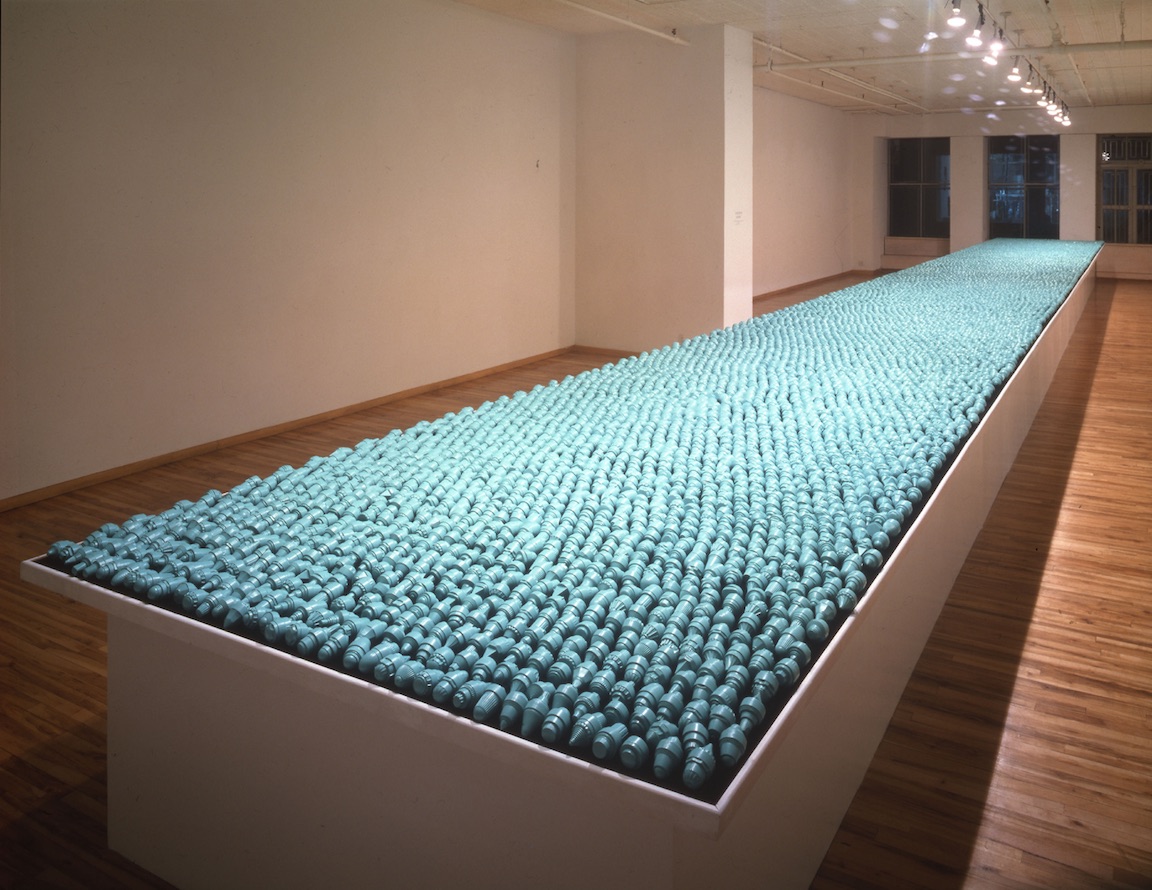
Allan McCollum, Over Ten Thousand Individual Works, enamel on cast Hydrocal, each 2" diameter by ca. 5". Installation: John Weber Gallery, New York, 1988.
McCollum: Some time between the mid-to-late '70s, the thinking about the distinction between the mass produced object and the unique object ceased to be very useful anymore. Going back to being in Los Angeles and San Francisco, people would look down on everybody from L.A. because they were "too commercial," "too industrial," "too artificial." They made movies, records, and this and that, just for money. They, the people from San Francisco, were beatniks, folk singers, and lived in communes and ate natural foods. This distinction between the two cities started to seem ridiculous, especially after the idea of DNA and RNA became popular, that there were codes for everything. So the conception of mass-produced objects being identical and unique objects bugged me from a lot of different directions. That was the motivation when I worked with Laurie Simmons in the mid-'80s. We came up with the idea of taking those tiny figures used in model train layouts and doing portraits of them through microscopes to show that these so called mass-produced toys, if you look at them up close, were all different. It's installed at the back of Mary Boone Gallery. That led to the idea of the Collection of Over Ten Thousand Individual Works (1987 – 89). I ultimately made over 30,000 unique things all based on stuff you find in stores. Making molds of all those things and putting them together in 30,000 unique ways so that they are all different from mass-produced objects. It was during that period that I started thinking about whether I was making "fake" artworks, or if people might think of them that way. And we all do this. We all make these fake distinctions. Before I did those dinosaur bones that I showed at the Carnegie Museum of Art, I had been wanting to do fossils for years. I was really interested in the question of "How do you make a new object that actually feels old and ancient?" It occurred to me that a dinosaur fossil is a copy. Like the Pompeii dog was a copy, but it was a copy made by nature so it was something a little different than a copy made in a factory. There was this irony in taking something natural and making duplicates from it when it already was a duplicate.
Rail: Right, a two-step removal.

Allan McCollum, The Dog from Pompei, 1991. Cast glass-fiber-reinforced Hydrocal, 21 x 21 x 21 inches each. Installation in Galeria Weber, Alexander y Cobo, Madrid, 1992.
McCollum: Questioning the difference between unique and mass-produced things is still in my work now, like in The SHAPES Project, where there is the possibility of making billions of unique shapes. I came up with a system to produce thousands and thousands of unique objects. It was a system so simple that I could have figured it out when I was in second grade. It wasn't a complicated system. But I wasn't a math expert. To figure out how many halves I had to make to come up with for the first 10,000-plus objects, I had to come up with an algebraic formula which took me around two weeks to figure out. I mentioned it to my friend Doug Drake, who worked with me in his Kansas City gallery, and he went, "Oh well it's N(N+1)/2, or something like that, I forget!" What? How did you figure that out? [Laughter.] He was an art dealer. I thought, "Oh, well he understands percentages."
Rail: [Laughter.] That was your first solo show outside L.A., in 1975. Then your first solo in New York was—
McCollum: At Julian Pretto and Co. in 1979.
Rail: But it was the two shows later in that year, at Artists Space and at 112 Workshop.
McCollum: Right, which became White Columns.
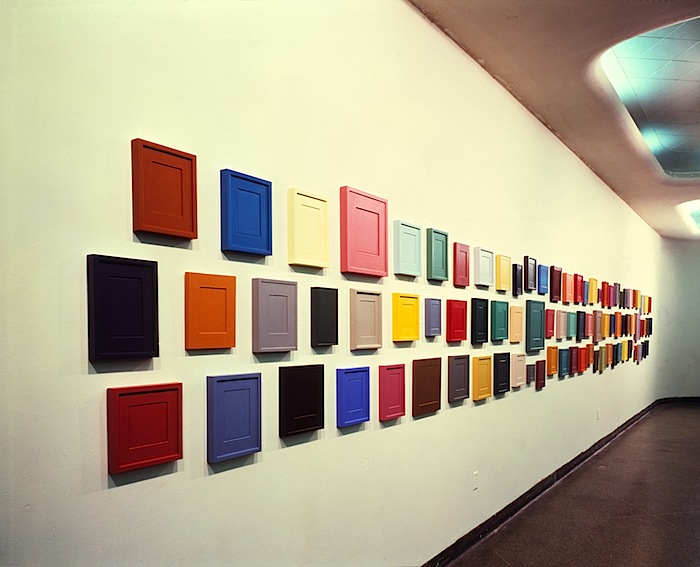
Allan McCollum, Surrogate Paintings, 1978-79. Acrylic and enamel on wood and museum board, each unique. Installation: 112 Workshop, New York, 1979.
Rail: That was when people began to pay attention to your work.
McCollum: Well, maybe in New York, because during those days, when you moved from L.A. to New York, everyone looked at you like you were an L.A. artist. Poo-poo. [Laughter.] Chris Burden and Mike Kelley changed everything. And Paul Schimmel helped by pushing from behind. Then L.A. suddenly became, in many ways, more interesting than New York.
Rail: From the mid-to-late '80s?
McCollum: Yes. And before that, in the '60s and '70s, if you wanted to succeed as an artist in New York, you could not possibly be an L.A. artist. Which is sad, because there was a whole generation of artists who influenced me in the '50s and '60s, who are finally getting shows in New York, like John McCracken, Larry Bell, and Billy Al Bengston. And then there was Craig Kauffman and other artists that used industrial materials in ways that influenced me. Using industrial materials and avoiding the so-called "art materials."
Rail: In a conversation we had in 2013, Constance Lewallen talked about her show [State of Mind: New California Art Circa 1970], that in L.A. in the late '60s to early '70s there was no infrastructure, no critical response or discourse, no art market whatsoever, which in some ways worked to the artists' advantage by allowing them to be playful and inventive with new materials and mediums, and whatnot.
McCollum: There probably was more than anyone realized. I remember talking to Peter Plagens not long ago—he used to live in L.A. and was writing for Artforum.
Rail: Before Artforum moved to New York in 1967.
McCollum: And after. Anyway, I was complaining to Peter that William Wilson wrote a review of a Daniel Buren show at Claire Copley's gallery in the L.A. Times and called him a geometric painter. He paid no attention to Daniel's social and critical practice. That's one of the many reasons I moved to New York. When the recession hit in the '70s, so many art galleries and museums including the Pasadena Art Museum were closing. I didn't know who to talk to, critically. I kept reading about New York, and I thought, "Well, I can't sell my art, but at least I could talk about it with interesting people if I moved to New York." The year I moved to New York, Mike Kelley moved to L.A. We once joked about how our planes must have crossed in the air. Chris [Burden] was really young when I was there [in L.A.]. He hadn't quite become the recognized artist that he would eventually become. Al Ruppersberg moved to New York, and ultimately moved back. Part of the reason I wanted to move to New York was for the intellectual challenge. I think the art world was more competitive. I thought the only way to succeed as an artist in L.A. was to go to art collectors' parties, and go to dinner parties. You had to mix with people that might collect your art if they liked you. I figured in New York you could survive without knowing art collectors, as long as you knew an art dealer. The art market is much bigger here. People would buy L.A. artists from the galleries in New York. I felt there was more of a challenge where artists were more competitive. You had to focus on something specific, on something that was interesting just to you, every "individual" outlook. I probably would have thought differently if I had gone to art school, but I didn't even have that competitiveness.
Rail: Before we go forward, I'd like to pick up from where we left off with Lynne's essay earlier. She brought up the issue of humor being different from the comic, from jokes, as she referenced Freud who thought that humor required an intense reevaluation of reality that is not at all resigned, but rather rebellious or subversive.
McCollum: My mother could have been a comedian. Almost everything she said was a joke—until she got mad, then she would scream at you. My brother became a comedian for a part of his life. So being funny was a major deal in my family. It was a way to cover up other emotions. There is a lot of irony and humor in my work. I've got a quote from Ed Ruscha where he says, "There's two kinds of art, one when you first see it you go 'wow!' and then you go 'huh?' Then there's the other kind where you go 'huh?' and then you go 'wow!'" [Laughter.]
Rail: I'll take the latter please.
McCollum: Me too. [Laughter.] Ruscha's work was just filled with the most amazing kind of humor and strangeness.
Rail: John Baldessari, William Wegman, and Ed Ruscha are familiar names when we speak of the L.A. art scene, but I feel William Leavitt is also an essential figure.
McCollum: Absolutely. I couldn't agree more.
Rail: He preferred to be low-key. That's why he's not as well known as the others. I'm thinking of his work partly because of his exploration of the vernacular culture of L.A. through the filter of the entertainment industry. Plus, he worked in so many mediums: painting, photography, installations, performances, etc.
McCollum: He worked in set design too. And Bill was one of the first artists that really got me in the '60s as a person my age. He and Al Ruppersberg were very good friends. They always have been. I saw a show of Bill's in 1967 or '68, where he had set up a space as if it were somebody's backyard. There were plants on the ground and some rocks and there was a speaker playing the sound of water rushing. [Laughter.] And I went, "Wow!" Bill's last show [Telemetry (2016)] at Greene Naftali was amazing. His work has gotten more strange. One of my heroes as a kid was Ray Harryhausen, the three-dimensional animator. He would do these paintings and drawings of the monsters before making the models. You can buy his paintings as souvenirs from reproduction companies. Leavitt is very much like that. He is low key, annoyingly so. [Laughter.] He's a very influential, very intelligent, and interesting person who makes interesting art. I'd say that Bill Leavitt, Bas Jan Ader, and a few others were a challenge to almost everything in a way, in a period when L.A. artists weren't being paid attention to. It could have been like, "We're sick of trying to impress the people in New York." But it also fits the whole history of California. Where people go out there to start a new life. Chris Burden was born in Boston. Mike Kelley in Wayne, Michigan. Billy Al Bengston in Dodge City, Kansas. Ed Ruscha in Omaha, Nebraska—just to name a few. Many L.A. artists came from somewhere else and maybe they enjoyed the freedom of not being looked down on by New England snobs.
Rail: The Puritanical establishment. [Laughter.]
McCollum: That's the nice way to say it. [Laughter.]
Rail: Were you aware of the Index of American Design, headed by Holger Cahill, who was the director of the Federal Art Project of the WPA during the New Deal in the '30s? The Index of American Design was an attempt to retrieve and record the native tradition of object making: folk objects, objects that were made for the millions by craftsmen or by untrained individuals—not artists. It was the time when Jacksonian democracy was the ideal sentiment which opposed the society of the elite.
McCollum: That was a kind of rebellion against the commodification of labor which created a lot of prejudices at the same time. But no, I'm not that familiar with that program. There's however, this interesting essay by Jennifer Jane Marshall [Clean Cuts: Procter & Gamble's Depression-Era Soap-Carving Contests, published in Winterthur Portfolio, 2008], which Lynne sent to me. It was about how people tried to rebel against the Industrial Revolution "commodifying" labor, and this caused a huge amount of problems during the Depression and so forth. People were furious at the loss of jobs, the disrespect for hand-work. The Ivory Soap Company held a contest where you could buy a big piece of soap approximately four by ten inches. An individual could carve and then send it in. Then they would decide who won and they'd get some money. And it was their way to try to eliminate the revolution of the people who work by hand, against the machines. And it worked. My mother used to have one of those bars of Ivory soap that you could carve into something else.
Rail: That's very eerie! Marsden Hartley once said, "Art in America is like a patent medicine, or a vacuum cleaner. It can hope for no success until ninety million people know what it is." And Warhol said a similar thing. "How many artists are there in America? And they are all pretty good."
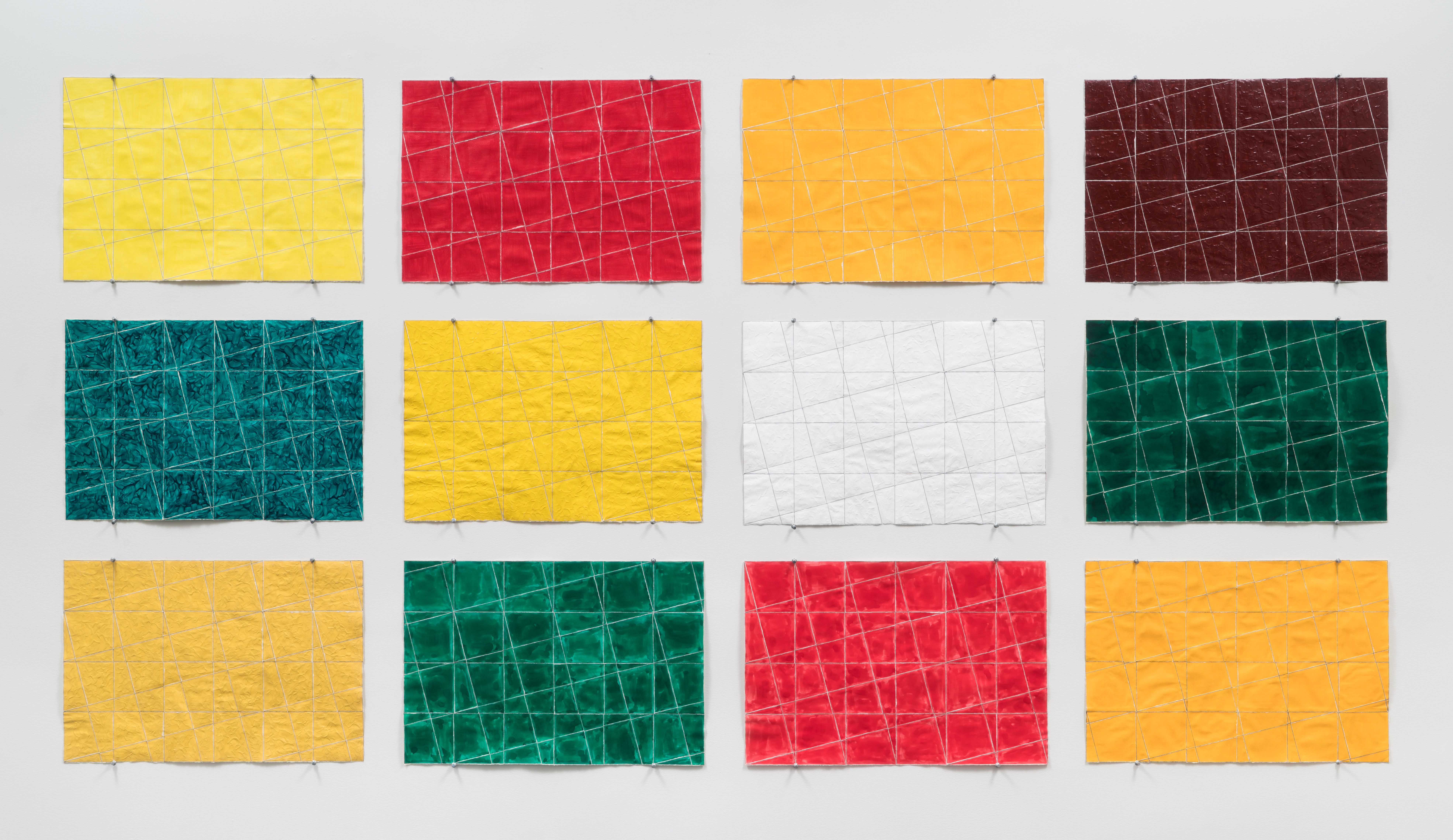
Allan McCollum, twelve Untitled Paper Constructions, 1975. 16 x 24 inches each. Acrylic paint, watercolor, colored pencil on paper. Each made up of 96 parts. Courtesy the artist and Petzel Gallery, New York.
McCollum: We can relate to both remarks to some extent. Well, ever since I started the Shapes Project in 2005, I've been working with home craft people. I worked with a couple that made cookie cutters in Maine, another couple that makes Christmas tree ornaments, a person that does cutouts of silhouettes, and someone who did rubber stamps. So then I did a couple of other projects because that inspired other people to contact me and ask if I would like to do something. I worked with sign painters in Idaho for a local art exhibition there. And these projects you've never seen in New York, you know? And there was this one that I recently did for a show on the WPA, it was subtitled "Art for the Millions." I actually bought the web domain "Art for the Millions." I own a number of web domains, in case I want to get into that. But because of the WPA, I thought of working with local entrepreneurs. They invited me to do this show in a museum in the middle of Oregon called the High Desert Museum. I asked the curator if she would take me around Bend, Oregon and let me meet entrepreneurs who do craft work. I met this woman, Delia Paine, who was so great, smart and interesting, and she made buttons to be worn. She had made 30,000 buttons that said "Vote for Obama," but she also made buttons about different local things for local stores. She invented a style of button where the background is a different color from the foreground. She buys all these antique papers from all over, they send them, and she cuts them up into circles and puts them onto the buttons. I asked if we could work together and she said yes. So we had this big show and she made over 6,000 buttons for me. Each one was a unique shape that I sent to her. She put it on plastic and chose her own color for the background. So it was collaboration with a young entrepreneur. It was very interesting working within a small town. I enjoy that type of project. My interest these days is turning towards the idea of distribution as an art form. Now you can have computers create a shape. With all the different things that computers do now, what's left? I've had certain ideas at times and people say, "Oh, no, anyone can do that on a computer." I forget. [Laughter.] But the idea of eBay and Etsy, and all those stores where local crafts people can sell things, where somebody packs it in a box and it gets sent to you from some small town in Tennessee and then you have something that they made, is pretty interesting to me. I don't know if it is to other people. But the idea of distribution and social practice can be mixed up in a way.
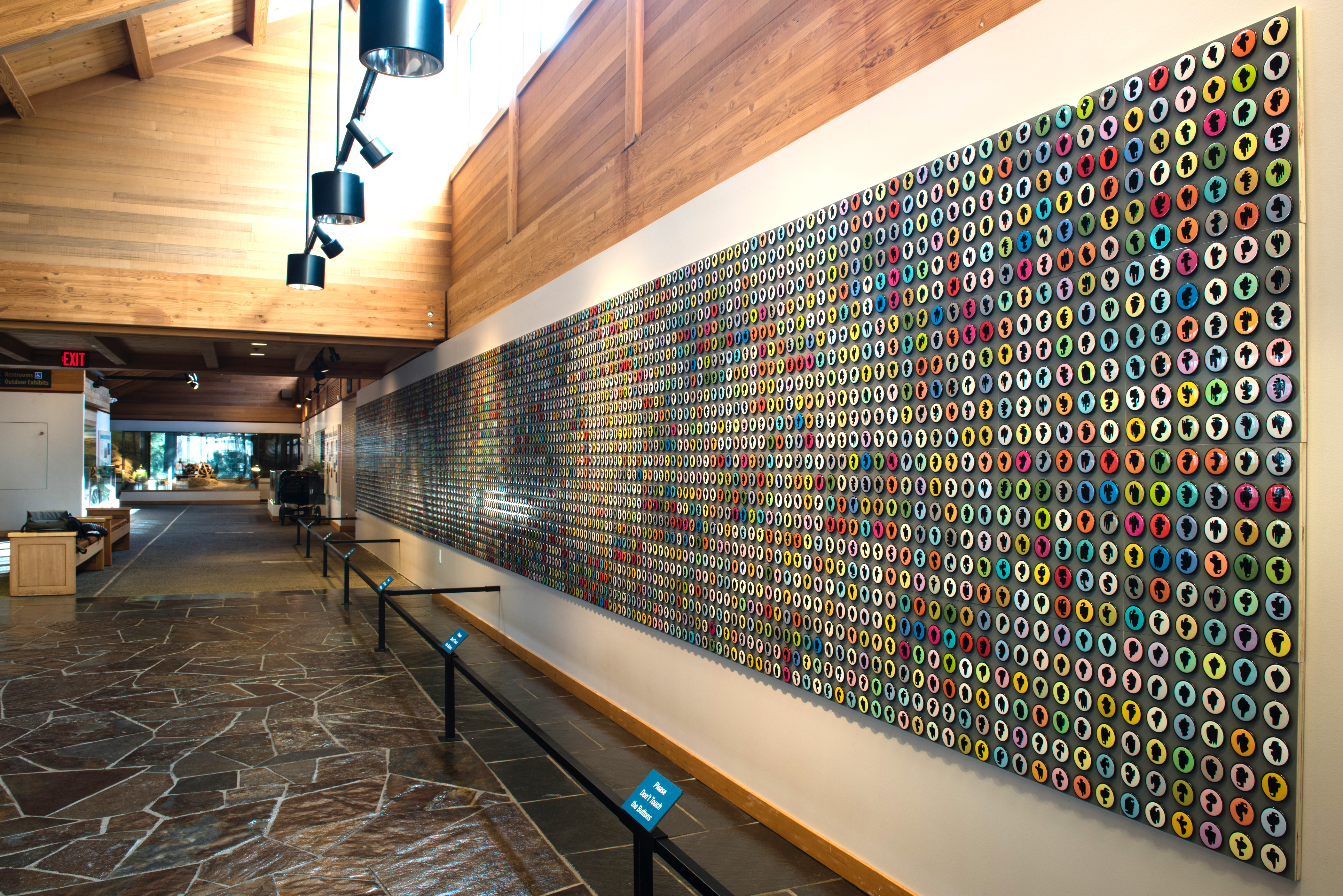
Allan McCollum, The Shapes Project: Buttons, 2016. Over six thousand hand-made buttons, each unique. Installation: High Desert Museum, Bend, Oregon, 2016.
Rail: A sense of participatory activity in a communal context is very rewarding for some of us, though not for those who have hermetic tendencies. Can I ask you a technical question about the Surrogate Paintings (1979)? You have a frame and you have a mat.
McCollum: They are depictions of a frame and a mat.
Rail: Which are normally made for drawings or photographs rather than paintings?
McCollum: When I came up with the idea of the Surrogate Paintings, I was thinking about painting but I very quickly got into thinking about photographs, or diplomas, or anything you can put in a frame and have on a wall. And I approached it in a kind of anthropological way. Why would these cubical rectangles be made with vertical sides called "walls"? And why are smaller rectangles "hung" on the walls? What's all that about? I remember reading an anthropological article about the Eskimos who never had walls. They lived in igloos, so the idea of putting something on a wall wouldn't occur to them. All the art they did was on the ground. Once they became more exposed and connected to so-called Western culture they started putting things on walls, but had no sense of upside-down or right side up. To them that wasn't a problem. [Laughter.] So the idea of putting something on the wall is unique to a certain way of seeing things in some cultures. Other cultures may put things up to look at, but not necessarily in the same way. The framed image was obviously an invention at a certain period in Western culture.
Rail: True, cave paintings were made on cave walls without boundaries. The idea of smooth prepared surfaces and the concept of boundaries is a much later development of humanity. As we all know, modern art, since the Renaissance, has grown stricter in terms of the unity of a painted image.
McCollum: It was one of my rebellions to get rid of boundaries from the very beginning. Those early paintings at Petzel could have been continued and continued. They're the opposite of what Hans Hofmann said: "The first four lines of your compositions are the edges of the canvas." You're already trapped with such restrictions, so I tried to think of ways to avoid it. The idea of tearing up hundreds of little squares of canvas and gluing them together, you can keep adding up or to the side, and go on for miles and miles. I guess you're right. Those years led me to the same way of looking at framed artwork. They both involve the concept of a framed artwork versus another way of seeing things. I chose to make the art gallery function as if you were walking onto a stage set, where the paintings weren't real, they were props made to look like paintings.
Rail: But in the case of the Surrogate Paintings they were made with frames, and each is like no other in size. In order for them to be added up like props, they have to multiply in response to the space.
McCollum: I did different types. The first Surrogate Painting show had nine paintings in this huge room that Julian Pretto was using in 1979 and there was ten feet of space between each one. Later, people started looking at them like I was just a monochromatic painter. It wasn't my thinking at all, but people kept calling it that. Then they would look at the frame as if what was inside was what the art was, and not the frame. That was when I started casting them in plaster so that, the frame and the mat and what was inside the mat was all just one piece. As you can see in the works of both shows, take the Untitled Paper Constructions, there's a similar focus on quantity, on handiwork. That was an idea about the invention of print shops where you could go have things printed, which didn't exist in my childhood. It wasn't until the mid-'60s that they were invented. So with the interest in quantity production, I was trying to design what I sometimes thought of as a kit, a way of combining all the different things, whether paintings, drawings, watercolors, prints, or photographs and so on, that we look at that are flat on a wall. I remember Liza Béar coming over and looking at my work, in the mid-'70s and she was laughing and said, "Oh, so you're making fake paintings." My response was, "Yes, you got it." [Laughter.] What else would you call them? It was the idea of working indefinitely with sixteen little shapes, with which you keep making grids perpetually and freely. Of course I was influenced by grid painters at the time, but I had one grid going at this angle and the other grid going at another angle, so there were two grids crisscrossing one another. I was interested, obviously, in crafts like quilt making, tile work, carpets, fabrics, etc., which was another strong influence in southern California that comes from Mexico, from Spain, from Arabia. There's little of that influence here in the East Coast.
Rail: Let me shift back to the idea of repetition and difference—
McCollum: Craig Owens wrote an article on me called Repetition & Difference [Published in Art in America in September 1983], which referred to Gilles Deleuze's book.
Rail: Difference and Repetition, in which he proposes repetition or the practice of multiplicities as ways to eliminate the dull repetitions of habits in order to experience the intense repetitions of memory, and the repetitions of death, though which we poke fun at our own mortality. In your own use of repetition and difference, as well as multiplicity, take The SHAPES Project or Shapes from Maine: Cookie Cutters for example, any tiny little difference gives itself the distinction of being different in that particular shape. But once you add all the shapes up, the overall effect may blind the viewer with similarities.
McCollum: I like to think that they notice that everything is different. I just felt that the distinction between the unique and the repetitive was a distinction that reflected our thinking about social class, which unfortunately is how we tend to see our society. I was born during the Second World War, having to horrifyingly discover what the Nazis had done by looking at a whole bunch of people as if they were alike. Many of my generation were turned off by the idea of a "hero." Artists decided that their work shouldn't be the result of a genius touch. It changed the way I wanted to look at art. Recognizing that the very wealthy first owned large sculptures, and the slightly less wealthy owned unique paintings, then watercolors, then drawings, then prints, multiples, posters, postcards, etc. It's a class system. I didn't want to be a part of that. Maybe it was partially a result of minimalists, individuals who made things that often looked as though they were all alike. Like Donald Judd for instance, making shows with works that have unique little differences. Or Sol LeWitt, an amazing artist. These people challenged a certain way of thinking that the artwork reflected the individual. They were done by craftsmen or, in the case of Sol LeWitt, by whomever had a pencil. They could execute the work without the presence of the artist. [Laughter.] The idea that we use objects to identity ourselves doesn't sit well with my conscience. A young student once sent me a text on Andy Warhol. He thought I might like his writings. The first paragraph described Andy Warhol's soup cans, and how Campbell's Soup was food for the poor. And I thought, "What! I spent my whole childhood eating Campbell's Soup. That signifies that I'm poor?" And I thought, "Andy Warhol grew up in a working-class family too. Who is this writer to say that Campbell's Soup is the soup of the poor?" I grew up in a neighborhood where I didn't even know what bread was. All the bread I ever saw was Wonder Bread. I didn't see anything else until I was in my twenties, when I was in Europe, especially in France where the varieties of bread were astonishing. Those issues do influence my choices as an artist.
Rail: When Warhol made the Brillo Box, constructed and silkscreened by someone else, he knew that it wasn't art unless it was displayed in the context of a gallery or museum. So there it goes both ways, the common object and the unique object.
McCollum: I wasn't interested in some certain mass-produced product. But I was interested in the idea of how many people are involved in making a particular mass-produced object. Yet we don't think of it as significant. I remember when I went to Mexico when I was thirty years old and there were all these people selling handmade things on the street. For fifty cents you could buy something somebody had carved out or painted. I remember thinking that a Donald Judd is not handmade yet you have to pay 50,000 dollars for it. There's this wonderful article by Bruce Boice, "The Quality Problem," [Published in Artforum in October, 1972] about who gets to decide who's a good artist. And there's no logic to it.
Rail: What about, to use Hal Foster's term, "situational aesthetics"? How do you frame the viewing experience through specific ways of installing the works in specific spaces?
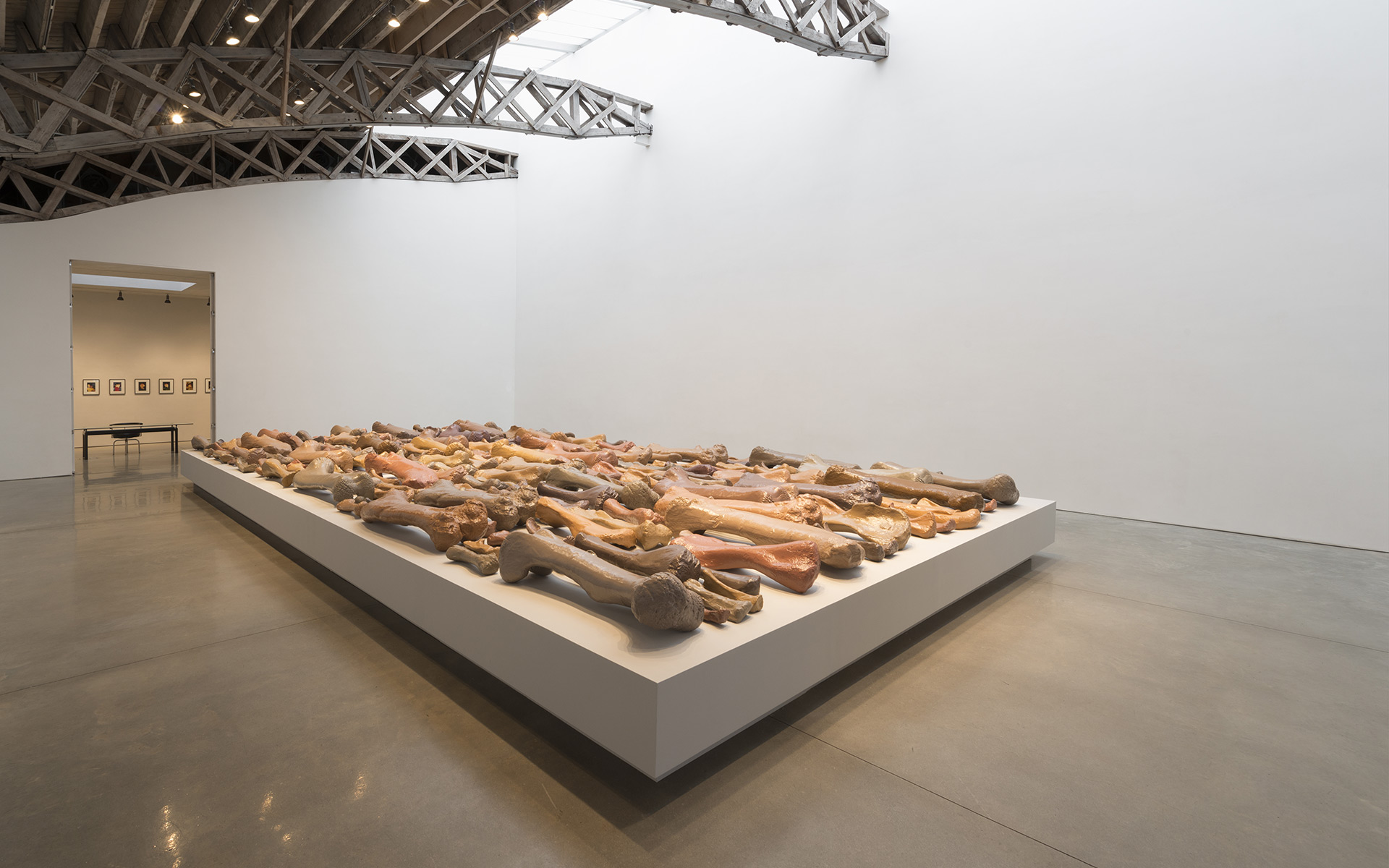
Installation view: Allan Mccollum, Collection of Two Hundred and Forty Lost Objects, 1991. Enamel/glass-fiber-reinforced concrete. Dimensions variable. Courtesy Mary Boone Gallery, New York and Petzel Gallery, New York.—
McCollum: As an artist, I was always interested in contextualizing and in addressing how context changes how we see things. The Surrogate Paintings were like artworks. The Perfect Vehicles are largely a reference to "usable" things that become artworks once they become historical. They were just useful objects before. So that was more a reference to the Metropolitan Museum that showed all those wonderful vases and objects. So I got into all these other models of display as I went along, like having objects on tables in a store, or on the wall in a frame shop or museum. But then I started thinking about local bake sales, garage sales, educational displays, and so on, which have their own conventions. I also became interested in how objects are displayed in science museums, which led me to works like Collection of Two Hundred Forty Lost Objects at Mary Boone. The base is very much like the base you would see in the Natural History Museum. In fact, Louise Lawler and I did a collaboration on a show For Presentation and Display: Ideal Settings (1983 – 84) at Diane Brown in 1984, which was simply about display referencing "show rooms." We had little bases that you would put display objects on, but then we used other wooden bases to put the smaller bases on. Essentially, the models of display, whether in a gallery or a hundred other settings, help us contextualize at an object. Certain types of displays are upper class, for example Saks Fifth Avenue, whereas others like Sears or Kmart are considered middle class. Art objects don't sell very well when you begin to play with these conventions. In those early Plaster Surrogate shows I did, like the one at Marian Goodman's in 1983, I wanted to sell some of the individual works for 100 dollars each, and there were over 500 of them. And it would take two hours to figure out which one to buy. It was impossible. [Laughter.] John Weber completely refused to do it when I wanted my individual works priced to sell for twenty dollars each. He said, "Allan, it takes just as long to write out an invoice for twenty dollars as it does to make one for 20,000 dollars." [Laughter.] But that's what I wanted to do. He was right. You can't make a living in the art world selling little things for twenty dollars each.
How did the collaboration with Andrea Fraser, May I Help You? (1991) come about?
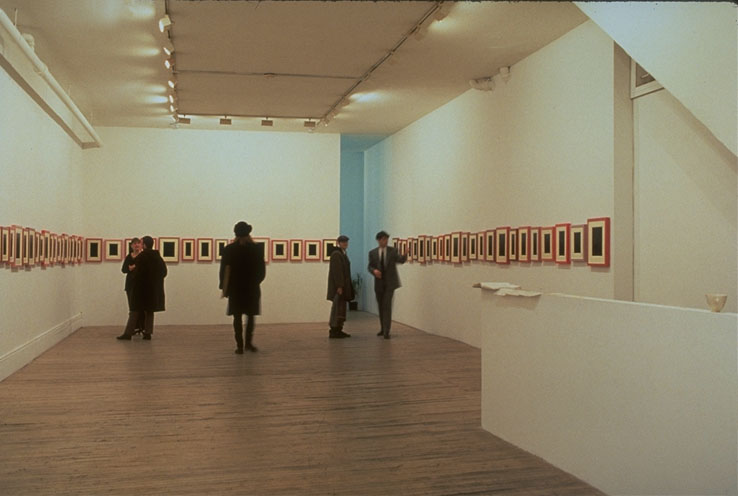
Andrea Fraser, May I Help You?, 1991. Performance produced in cooperation with Allan McCollum, American Fine Arts Co., New York.
McCollum: I met Andrea through Thomas Lawson when she was a brilliant eighteen-year-old. Craig Owens, who was one of the editors of Art in America, was so fascinated by her intelligence. She got to know Louise Lawler at the time and wrote an article about her work that Craig printed in Art in America when Andrea was nineteen or twenty. She became my assistant when she was eighteen or nineteen and we worked together on the Plaster Surrogates. We became friends. And since all her work had been performances, or about institutional critiques, she had been resisting commercial situations. So when she was invited to do a show at American Fine Arts, I said, "Do it as a critique of 'selling.' Address the idea of what an art gallery is." She agreed. I basically made the stage set for her by filling the American Fine Arts gallery with Surrogate Paintings with different shades of red on the frames, then she totally invented the performance herself. It had nothing to do with me in that sense, except for a few quotes which she incorporated from an interview with me for Arts Magazine [with D.A. Robbins] into the monologue. She was poking fun at the whole idea of fine art, people who buy it and people who own it.
Rail: I thought it was effective as an installation right in front in the foyer when you walk in.
McCollum: I told Mary that I wanted the installation to look like a Bill Leavitt. I wish we could have a potted plant next to it. [Laughter.]
|
